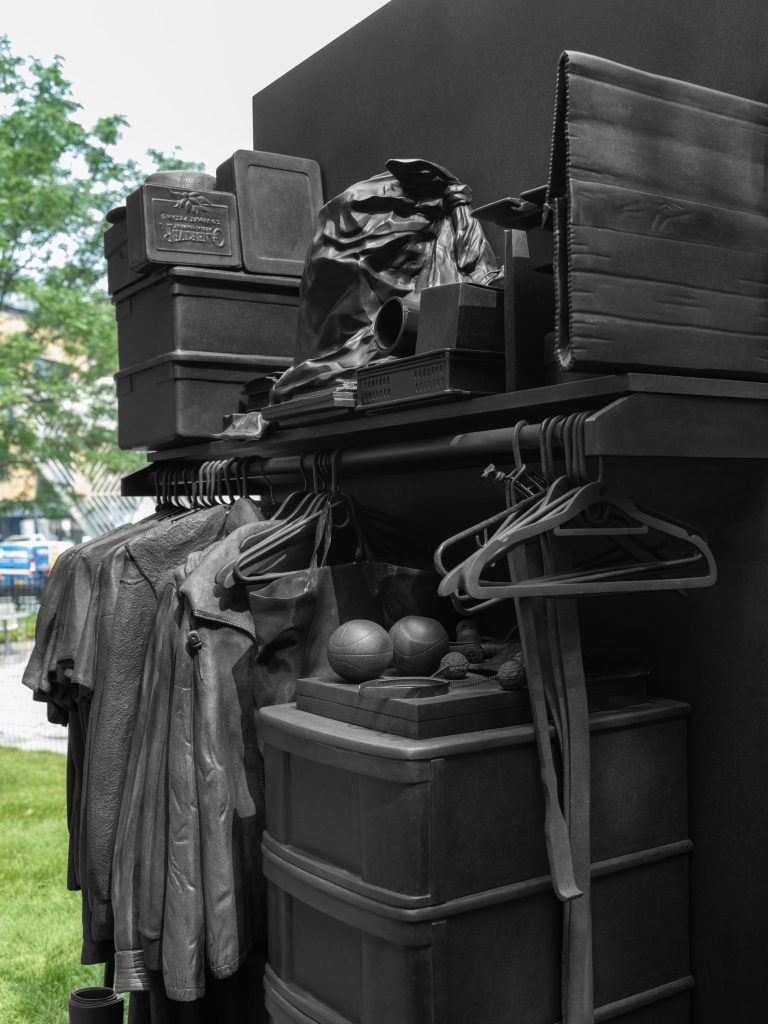
In New York’s AIDS Memorial Park, there is now an open closet. Inside the closet, you can find hangers and hoodies, stacked boxes, and folded weekend bags. At first glance, it appears to be a generic storage space, but it is more than that.
Artist Jim Hodges created a memorial called Craig’s Closet (2023) to honor the over 100,000 New Yorkers. They lost their lives during the HIV/AIDS epidemic, some of whom were Hodges’ friends and colleagues. The piece is meticulously crafted in granite and bronze, painted in a haunting, funereal black.
Even without knowing the title of Hodges’ sculpture, it becomes clear that it was based on a specific individual. The artwork’s attention to detail, down to the wrinkles on the shirts. It indicates that it is a recreation rather than a product of pure imagination. However, the identity of Craig remains unknown. We are unaware of Craig’s last name, relationship to the artist, or the circumstances of their passing.

Installation view: New York City AIDS Memorial Park; Presented by the New York City AIDS Memorial, June 9, 2023-May 31, 2024 © Jim Hodges, Courtesy of the artist and Gladstone Gallery
. Photography by Daniel Greer.
Hodges deliberately chose not to disclose this information. Because he wants to avoid speculation about his personal connection to the subject matter. In an interview, he expressed that the personal aspect is evident within the work itself. And it expands on that narrative would divert attention from the piece’s universal significance.
This tension is just one of many present in the artwork. Craig’s Closet is intimate yet anonymous, its materials are hard while its subject matter is soft. It possesses the strength and weight required of public art, built to withstand weather and crowds. However, its symbolism represents the fragility of life.
Hodges, a resident and artist in New York, arrived in the city during the mid-1980s as an emerging artist. In that time, the HIV/AIDS epidemic was at its peak. He personally knew many individuals affected by the crisis, including his close friend Felix Gonzalez-Torres, who passed away from an AIDS-related illness in 1996. Yet, when asked about these experiences, Hodges redirects the focus away from himself and towards the history of the site where his artwork stands.
Nearby stands St. Vincent’s Hospital, once referred to as the “ground zero” of the AIDS epidemic, as well as the Greenwich Village neighborhood, which has been home to generations of artists, activists, and performers. Hodges aimed to utilize the space and its historical context as a portal for people to connect with based on their own references. The reflective back of the sculpture allows viewers to catch glimpses of themselves within the work.

By choosing the closet, an already loaded metaphor, as his memorial, Hodges reveals much about his intentions. The sculpture subverts the idea of the closet as a space for hiding identities and instead presents it as a stage on which we display the tokens of our lives.
In describing his piece, Hodges wrote, “The scene is set, and narratives blossom whenever the doors swing open. This opening gives us a reminder, an understanding of who we are, where we have been, secrets, and the dreams we hold.”
The meticulous craftsmanship of the sculpture reflects Hodges’ personal investment, even if he chooses not to discuss it. He believes that creating a work that evokes emotions requires an immense amount of love. “That’s the standard: loving it,” he said.
Craig’s Closet (2023) can be viewed in the New York City AIDS Memorial Park until May 2024.

